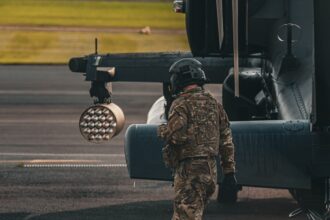In the aftermath of World War II, the world found itself grappling with the remnants of a conflict that had not only reshaped borders but also the very fabric of technological advancement. The Nazi regime had invested heavily in research and development, producing innovations that ranged from advanced weaponry to groundbreaking medical techniques. As the dust settled on the battlefield, a new kind of race began—one that sought to uncover and harness the technological prowess that had been cultivated under the Third Reich.
This hunt for Nazi technology was not merely a quest for knowledge; it was a strategic imperative for the Allied powers, who recognized that the spoils of war could dictate the balance of power in the emerging Cold War landscape. The urgency of this hunt was underscored by the fear that Soviet forces might seize these technological advancements for their own purposes. The Allies understood that whoever controlled this knowledge would have a significant advantage in the geopolitical arena.
Thus, intelligence agencies and military leaders embarked on a systematic search for Nazi research facilities, laboratories, and documents, hoping to extract as much information as possible before it fell into rival hands. This endeavor was fraught with challenges, as many scientists and engineers had either fled or were unwilling to cooperate, fearing repercussions for their past affiliations.
Key Takeaways
- The hunt for Nazi technology led to the uncovering of secret research facilities and the recovery of stolen technology.
- Operation Paperclip facilitated the recruitment of German scientists by the Allied forces, contributing to the race to uncover and replicate Nazi technology.
- Allied intelligence agencies played a crucial role in recovering stolen Nazi technology and using it for post-war developments.
- The impact of Nazi technology on post-war developments raised ethical dilemmas regarding its use and repurposing for civilian use.
- The legacy of Nazi technology continues to influence modern warfare and industry, prompting ongoing efforts to identify and recover stolen technology.
Operation Paperclip and the Recruitment of German Scientists
One of the most significant initiatives undertaken by the United States in its quest for Nazi technology was Operation Paperclip. This clandestine program aimed to recruit German scientists, engineers, and technicians who had worked on advanced military projects during the war. The U.S. government recognized that these individuals possessed invaluable expertise that could be leveraged for American interests, particularly in the fields of aerospace, rocketry, and medicine. Despite the moral complexities surrounding their recruitment—given their previous affiliations with the Nazi regime—American officials justified their actions by emphasizing the potential benefits to national security and technological advancement. Operation Paperclip was not without its controversies. Many of the scientists brought to America had been involved in unethical experiments or had contributed to weapons programs that caused immense suffering during the war. Yet, as the Cold War intensified, the U.S. government prioritized expediency over ethical considerations. Figures such as Wernher von Braun, who played a pivotal role in developing the V-2 rocket for Nazi Germany, became instrumental in advancing American space exploration efforts. The recruitment of these scientists marked a significant turning point in U.S. military and technological capabilities, illustrating how wartime adversities could be transformed into peacetime advantages.
The Race to Uncover and Replicate Nazi Technology

As Operation Paperclip unfolded, a parallel race emerged among Allied nations to uncover and replicate Nazi technology. The British, French, and Soviets were equally eager to tap into the wealth of knowledge left behind by the defeated regime. This competition spurred a flurry of intelligence operations aimed at locating key research sites and securing documents related to advanced technologies.
The urgency of this race was palpable; each nation sought to gain an edge over its rivals by harnessing innovations that could redefine military strategy and industrial capabilities. The efforts to replicate Nazi technology were not limited to weaponry alone. Research into jet propulsion, guided missiles, and even medical advancements became focal points for various nations.
The British, for instance, were particularly interested in jet engine technology, which had been pioneered by German engineers during the war. Meanwhile, Soviet scientists worked tirelessly to reverse-engineer captured German equipment, leading to significant advancements in their own military capabilities. This race not only highlighted the importance of technological superiority in post-war geopolitics but also underscored the lengths to which nations would go to secure their interests.
The Role of Allied Intelligence Agencies in Recovering Stolen Technology
| Agency | Role | Technology Recovered |
|---|---|---|
| CIA | Covert operations and intelligence gathering | Advanced weapon designs |
| MI6 | International espionage and counterintelligence | Nuclear research data |
| MOSSAD | Covert operations and cyber intelligence | Stolen military drone technology |
Allied intelligence agencies played a crucial role in recovering stolen Nazi technology during and after World War
The intelligence agencies employed various methods to gather information, including interrogations of captured German scientists and reconnaissance missions to identify hidden research facilities. These efforts were often complicated by the chaotic aftermath of the war, as many scientists were either uncooperative or had gone into hiding. Nevertheless, through persistence and ingenuity, Allied intelligence managed to piece together a comprehensive understanding of Nazi technological advancements.
This information would later inform military strategies and contribute to significant developments in various fields, from aerospace engineering to medicine.
The Impact of Nazi Technology on Post-War Developments
The impact of Nazi technology on post-war developments cannot be overstated. The innovations that emerged from Germany during the war laid the groundwork for numerous advancements in both military and civilian sectors. For instance, rocket technology developed by German scientists became foundational for space exploration efforts in both the United States and Soviet Union.
The successful launch of satellites and manned missions into space can be traced back to the principles established by Nazi engineers. Moreover, medical technologies developed during the war also found new applications in civilian life. Techniques for treating injuries sustained in combat were adapted for use in hospitals, leading to improved surgical practices and trauma care.
The legacy of Nazi technology extended beyond mere military applications; it permeated various aspects of society, influencing everything from transportation systems to healthcare practices. As nations sought to rebuild and innovate in the post-war era, they found themselves drawing upon a reservoir of knowledge that had been cultivated under one of history’s most oppressive regimes.
The Ethical Dilemmas of Using Stolen Nazi Technology

Despite the undeniable advancements made possible by Nazi technology, ethical dilemmas loomed large over its use. The recruitment of former Nazi scientists through programs like Operation Paperclip raised questions about complicity and moral responsibility. Many individuals who contributed to horrific wartime atrocities were now being celebrated as pioneers in their fields, leading to a troubling juxtaposition between their past actions and their current contributions.
Furthermore, the implications of utilizing stolen technology extended beyond individual scientists; they raised broader questions about accountability and justice. Should nations benefit from knowledge acquired through unethical means? This dilemma became particularly pronounced as discussions surrounding reparations and justice for victims of Nazi atrocities gained momentum in post-war discourse.
The legacy of Nazi technology thus became intertwined with ongoing debates about morality in science and technology, challenging societies to confront uncomfortable truths about their pasts while navigating their futures.
The Legacy of Nazi Technology in Modern Warfare and Industry
The legacy of Nazi technology continues to resonate in modern warfare and industry today. Many innovations developed during World War II have been adapted and refined over subsequent decades, influencing military strategies and industrial practices worldwide. For instance, advancements in missile technology have evolved significantly since their inception under Nazi Germany, shaping contemporary defense systems and international relations.
In addition to military applications, Nazi technological innovations have also found their way into civilian industries. The principles behind jet propulsion have been instrumental in revolutionizing air travel, while medical technologies developed during the war have paved the way for breakthroughs in healthcare. As industries continue to evolve, they often draw upon historical advancements that can be traced back to this tumultuous period in history.
Thus, while Nazi technology emerged from a dark chapter in human history, its influence persists across various sectors today.
The Uncovering of Secret Nazi Research Facilities
The uncovering of secret Nazi research facilities became a focal point for Allied forces seeking to understand the full extent of Germany’s technological capabilities during World War
One notable example is Peenemünde, where German engineers developed advanced rocket technology that would later influence space exploration efforts worldwide.
These findings underscored the importance placed on technological superiority during wartime and highlighted how such investments could yield significant advancements with far-reaching implications.
The Role of Resistance Movements in Revealing Nazi Technology
Resistance movements played an essential role in revealing Nazi technology during World War II by gathering intelligence on German scientific advancements and sabotaging key projects. Individuals within these movements often risked their lives to expose information about secret research facilities or technological developments that could be used against Allied forces. Their efforts contributed significantly to understanding how far-reaching Nazi innovations had become.
For instance, members of various resistance groups worked tirelessly to disrupt supply lines or sabotage production facilities associated with advanced weaponry programs. By undermining these efforts from within, they not only hindered Germany’s military capabilities but also provided valuable insights into ongoing research initiatives that could be exploited by Allied forces once they gained access to captured materials or personnel.
The Repurposing of Stolen Nazi Technology for Civilian Use
In addition to military applications, many innovations derived from stolen Nazi technology found new life in civilian contexts after World War
For example, advancements made in aerodynamics during wartime led to improvements in commercial aviation design and efficiency. Similarly, medical techniques developed under duress found new applications in hospitals around the world—transforming once-controversial practices into standard procedures that saved countless lives. While repurposing these technologies raised questions about their origins, it also highlighted humanity’s capacity for innovation even amidst dark histories.
The Ongoing Efforts to Identify and Recover Stolen Nazi Technology
The quest to identify and recover stolen Nazi technology remains an ongoing endeavor for historians, researchers, and governments alike. As new information surfaces regarding hidden caches or previously undiscovered research facilities, efforts continue to piece together this complex puzzle from history’s shadows. Organizations dedicated to preserving historical records work tirelessly alongside intelligence agencies seeking accountability for past injustices while ensuring that valuable knowledge is not lost forever.
Moreover, contemporary discussions surrounding reparations and justice for victims of wartime atrocities have reignited interest in uncovering how stolen technologies were utilized post-war—and who benefited from them most significantly. As societies grapple with their legacies—both good and bad—the pursuit of understanding remains vital not only for historical accuracy but also for fostering dialogue about ethics within science and technology today. In conclusion, while much has been achieved through harnessing knowledge derived from Nazi technology since World War II ended—its legacy continues to evoke complex emotions surrounding morality within scientific advancement today—challenging societies worldwide as they navigate their pasts while striving toward brighter futures built upon lessons learned along this tumultuous journey through history’s shadows.
In the aftermath of World War II, the race to acquire advanced Nazi technology became a significant focus for the Allied powers. This pursuit led to the controversial Operation Paperclip, where the United States recruited former Nazi scientists to gain an edge in the burgeoning Cold War. An interesting article that delves into the intricacies of this operation and the broader implications of acquiring stolen Nazi technology can be found on the War Room website. For a deeper understanding of how these technologies influenced post-war advancements, you can read more in this related article.
WATCH THIS! 🪖How Stolen Nazis Built Cold War Power
FAQs
What is stolen Nazi technology after WW2?
Stolen Nazi technology after WW2 refers to the acquisition and utilization of advanced technology developed by the Nazi regime during World War II by various countries and organizations after the war ended.
What kind of technology was stolen?
The stolen Nazi technology included advancements in rocketry, jet propulsion, aircraft design, submarine technology, and medical research, among others.
Who stole the Nazi technology?
Various countries and organizations, including the United States, Soviet Union, and other Allied powers, actively sought to acquire and utilize Nazi technology after the war.
How was the stolen technology used?
The stolen Nazi technology was used for military and scientific purposes, leading to advancements in missile technology, aerospace engineering, and medical research.
What impact did the stolen technology have on post-war developments?
The stolen Nazi technology significantly influenced post-war technological advancements, particularly in the fields of aerospace engineering, missile development, and medical research. It also contributed to the space race between the United States and the Soviet Union during the Cold War.




